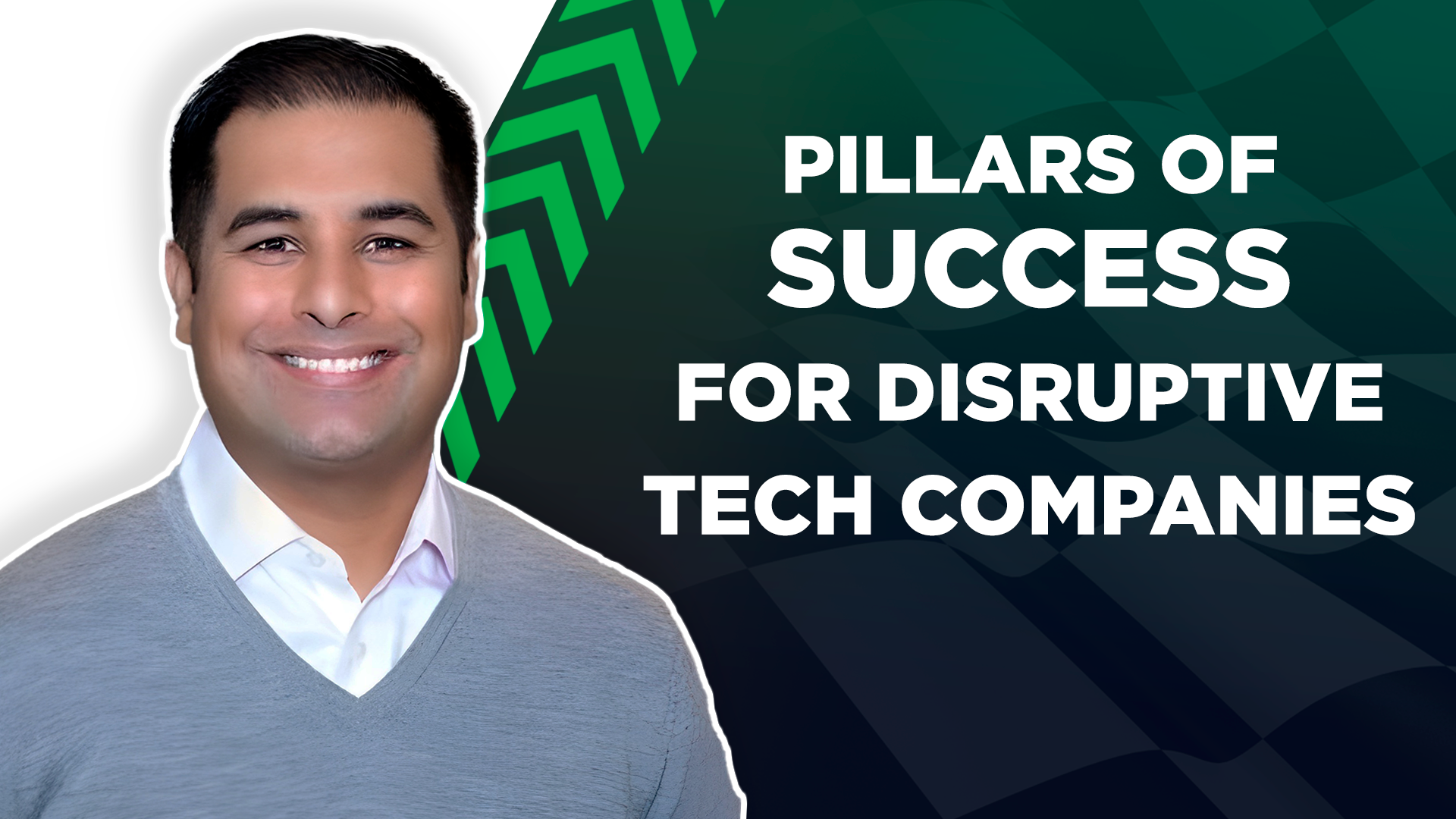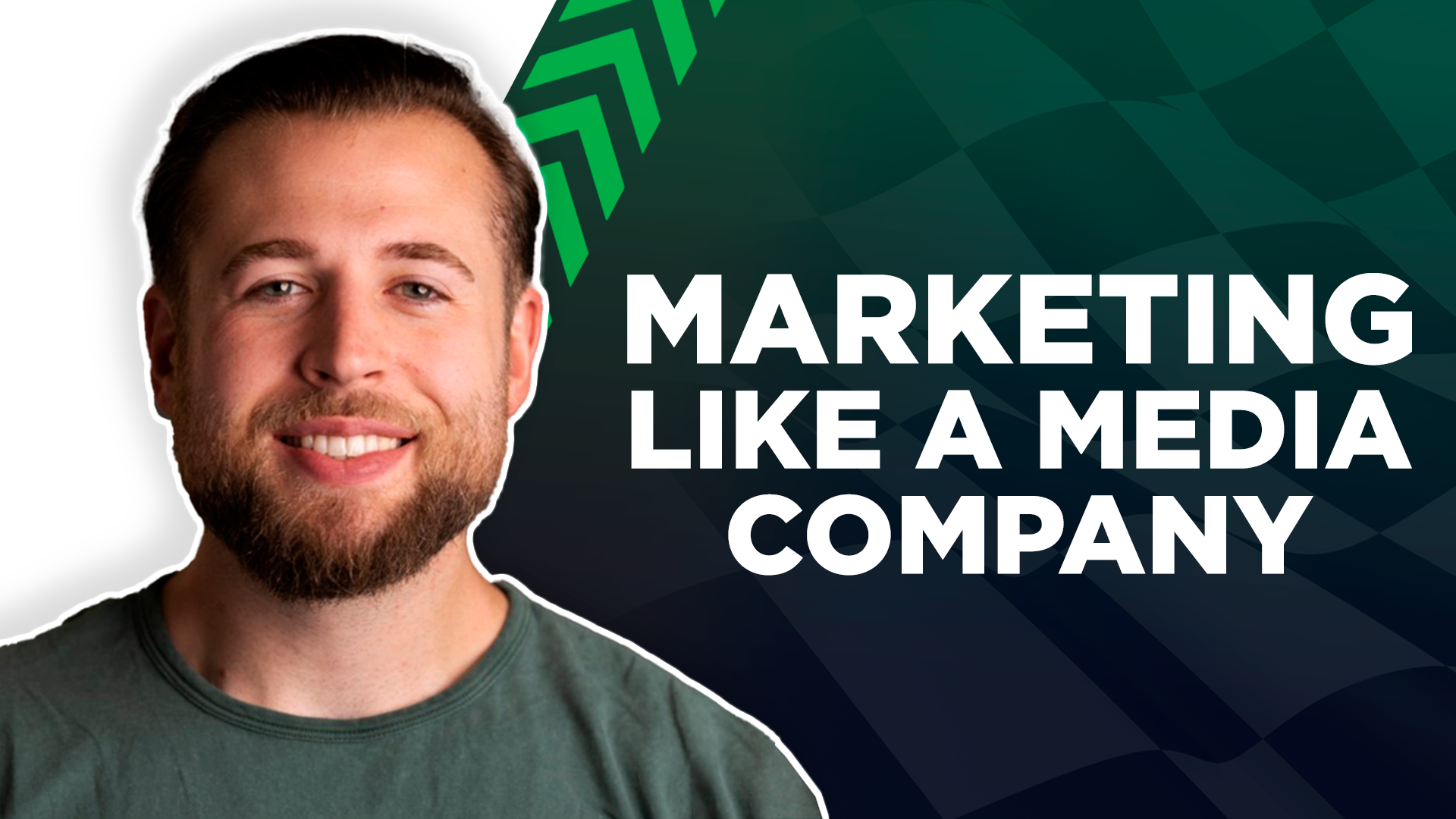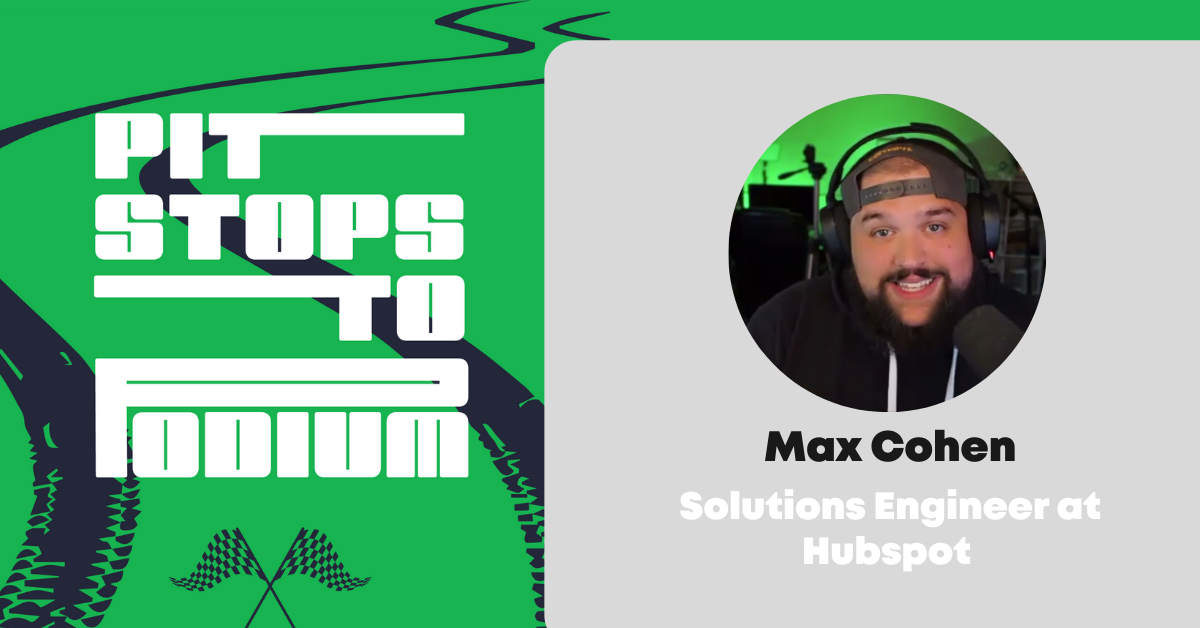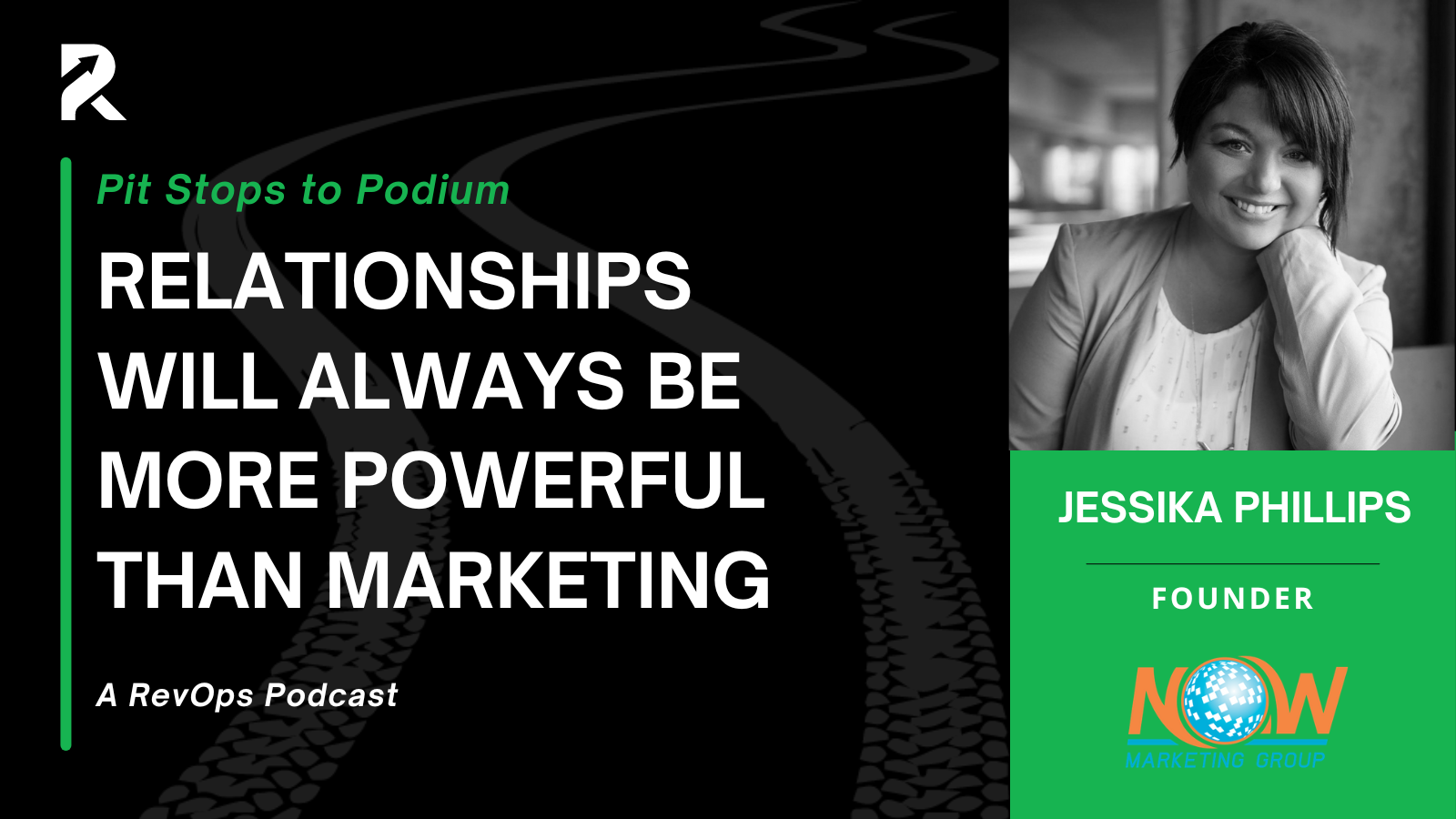Table of Contents
Pillars of Success for Disruptive Tech Companies
In episode 73 of Pit Stops to Podium, we sit down with Ratan Manehani, Partner at Fort Ross Ventures, a venture capital firm that specializes in investing in mid to late stage technology companies in the U.S. Ratan brings with him a wealth of experience from his decade-long career in working with and investing in disruptive technologies and business models.
Our conversation with Ratan focuses on the pillars of success for disruptive tech companies. We explore the benchmarks that companies should be aware of on unit economics and the importance of incorporating product into post-market fit scaling. Ratan shares valuable insights on how to maintain a product's competitive edge in a constantly changing market and what metrics to monitor to optimize unit economics for growth.
If you’re ready to learn from one of the best, then buckle up and hold on!
Pitstop Highlights
What Are the Pillars of Success?
You need a few things:
- A fabulous team
- A wonderful market
- Product-market fit is clear (launched MVP, iterated it, customers are paying for it)
The question...what is your scaling function and how is it going to scale? Some want to focus on their core market, some want to expand their market, some want to expand their product. etc...
Companies need to focus on true, fundamental growth and consider these questions:
- Do you have good business econ?
- Do you have the right sales efficiency?
- Are you building the right team in the right structure?
"For me, the core function is you've got good revenue, you've got a good product, you've got a good team. Now what way are you going to grow?"
Benchmarks To Be Aware Of On Unit Economics
Gross margin is becoming extremely important and the target number is 80% (investors want to see a baseline of 60% moving to 80%). This could happen overnight, or it could take a couple of years. This benchmark is important when evaluating a SaaS business because it tells how much money you can spend efficiently and effectively on sales and marketing.
In the sales efficiency realm, an emerging problem is top-of-the-funnel. Budgets are much tighter than they were a few years ago (can't hire or spend as much as they want). There is now a laser focus on who is your ICP (Ideal Customer Profile). Efficiency and time spent on your ICP is going to bring in the most money.
From a metrics perspective, close rates need to be over 25%.
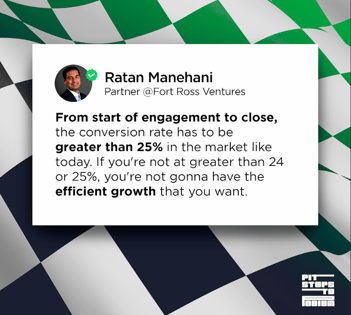
Also important is time-to-close. Sales cycles in the enterprise realm had previously been in the 6-8 month (and occasionally 12 month) range. These have now increased to over 12 months as customers are just not ready to buy.
With CAC (customer acquisition cost), it will continue to be high, but if you have your ICP dialed in, you may see efficiency in CAC. It's important to focus on post-customer engagement and retention to determine what the right CAC to LTV is.
Incorporating Product into Post-Market Fit Scaling
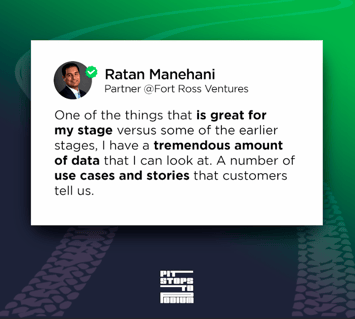
From a qualitative perspective, one of the most important things is how much the customers love the product and how much value they gain from it. Quantitative factors which indicate this are how much usage is it, how much has the account grown over a period of time, how much has the account churned and propensity to pay rates.
It's important to consider the core metrics that are going to drive the business. One of them is retention (looking at what is net retention? what is churn? NRR?). These can often determine if a business can grow over the long term.
Connect with Ratan
Email: ratan@fortross.vc
LinkedIn: https://www.linkedin.com/in/ratanmanehani/
Full Transcript
Brendan: Hey everyone, welcome to Pit Stops to Podium, the RevPartners podcast where we talk to execs who have competed and won in taking their companies from high growth to high scale, my name is Brendan Tolleson and I serve as the co-founder and CEO of RevPartners and I'm delighted to have with me today Ratan Manehani for this episode of Pit Stops to Podium, welcome Ratan.
Ratan: Hi, how are you
Brendan: I'm doing well and for those that may not know who you this is a great opportunity to share a little bit about who Fort Ross Ventures is and how you got to Fort Ross.
Ratan: Yeah happy to do it well thanks for having me um you know Fort Ross is a fairly new Venture fund we started in 2013 and today we have three funds under management roughly 600 million and our primary focus is on growth stage companies so series B through pre-ipo and SaaS in addition to fintech which we have some expertise in as well but I'll mainly highlight a lot of the SaaS topics today in terms of how I got here you know it's I have a very unique background when you look at it on a traditional Venture investor not a traditional technologist but I've been involved in a multitude of businesses um in a variety of roles and what brought me you know to Fort Ross was those experiences that I had in the past I was assisting large corporations on Innovation working within within tech companies and helping them scale them and also has a private Equity investor and one day I woke up and I said I want to be a venture investor and found my path to Fort Ross and you know just as they were launching too and it's been a wonderful wonderful experience and I've really enjoyed being on the Venture side versus all the other roles I've been in.
Brendan: That's great well I appreciate you sharing a little bit about the origin story it's always fascinating to hear how people got to the the seat they're in now we'll talk a little bit more about kind of you know what you've experienced at Fort Ross as it relates to assessing deals and and supporting uh portfolio companies but before we do that uh we do have a tradition here at Pit Stops to Podium and that's to get to know our guests outside of work uh because we're human beings not human doers and so what are what are a few fun facts our audience should know about you outside of work?
Ratan: Yeah I'm an avid basketball player and fan um you know throughout my youth and even into college I you know one of the big dreams I had is to be an NBA player but at one point I stopped growing and so that dream kind of went to the Wayside but and I still still love going out every weekend or you know playing some hoops and I've got quite quite the three-point shot so I I nothing like Steph Curry's but pretty good at the end of the day so and something unique about me and my competitive nature even in work um you know comes from my roots in basketball.
Brendan: Safe to assume you are a Warriors fan given you live the Bay Area and has Steph Curry.
Ratan: Yeah no a reformed uh uh originally I was with the Rockets, but all this winning going on I definitely joined the bandwagon
Brendan: Well you had the mid 90s for the Rockets so there was a good little run there with was it Hakeem Olajuwon and uh yeah Smith and Robert Horry those guys.
Ratan: Yeah Hakeem and Clyde are the ones that brought me into basketball early on and um great run there um hopefully they'll rise again.
Brendan: Yeah it's been a little bit of a dark spell the last few years I guess they had the they had it going for a while but now they're kind of in the cellar these days um yeah well let's uh let's transition into the big idea and so one thing we talked about just in terms of your investment um firm ultimately who you invest in from a thesis perspective uh I think you have a unique lens as it relates to what to be looking for uh from a company and let's talk about the pillars of success for disruptive tech companies um so you'd mentioned series B to pre-ipo and so there's a lot of um just learnings that you've gathered in that period of time um and so let's start when we talk about pillars of success um like what how would you define what those pillars are let's put some descriptive words around those pillars.
Ratan: Yeah so you know by the time by the company is a series B phase um and these definitions of series B are Broad and they can be three million in Revenue can be upwards of 10 million in Revenue but the key pillars that we look for are you know a fabulous team um a wonderful Market that is developed or defined by that stage um product Market fit is is clear now uh meaning you've launched the MVP you've iterated it you've obviously got customers paying for it now um how is that going to expand um as you function and get into the scaling function um and so my point at series B is what is that sailing scaling function and how is it going to scale and there's many iterations around that scaling function uh you know some companies uh you know will focus fairly on the core Market their hats some will say I want to expand their Market some will say I want to expand their product and so for us it's to assess what what is the right stage that they're at and where they're going to go and so for me the core function is you've got good Revenue you've got a good product you've got a good team now what what way are you going to grow um and and for me uh what I like to see is companies focusing on at least in this market today is on true fundamental growth in the last couple years we have focused on Purely year-over-year growth without focusing on economics sales efficiency all these key components that are becoming more and more important and so I've always had that lens because of my background not only not being in Venture purely but looking at it from a true operating sense and so when I'm looking at businesses do you have good business econ do you have the right sales efficiency are you building the right team and in the right structure do you have the right folks in the right role and if you those things line up then I think hyperscale or are the scaling functions are going to play out really well um and so that's what's really important to me when I'm looking at a deal versus just looking at the product and the team it kind of all comes together.
Brendan: Yeah it seems to your point about like series B um it's no longer idea like there is traction uh and so there's that product Market fit to your point and then it gets into like how what's the path for like sustainable growth um and so that seems like that's been that trend of going from scalable to sustainable like growth at all costs to how do we do more with less um and so when you talk a little bit about you mentioned some of the things around like sales efficiency but let's double click on that whole concept of like the business model and you you know unit economics um like what are those benchmarks that our team or our audience should be aware of when you think of things like like CAC rule for whatever those that can whatever those models are that you are tracking I think it'd be helpful our audience because I know that there's a heightened emphasis on that uh in this current economic landscape.
Ratan: Yeah so you know maybe we'll we'll start in the kind of business uh economics area you know gross margin is becoming extremely important particularly in this segment and and it's been distorted you know fundamentally we've been seen all businesses should be trending towards that 80 gross margin rate but there's been some Distortion with new technologies um you know utilizing Ai and compute power that usually brings it down but there's opportunity for efficiency with scale um and so it's it's trying to find that balance and as an investor looking at it and saying is this the true state of the gross margin or are we going to see some additional efficiency either by a scale or or even buy a you know uh cost savings and so we're all trying to Trend toward that 80 sometimes that March happens overnight sometimes that March takes a couple years but as investors we want to see a baseline of at least 60 marching towards that 80 percent um and so I think that's extremely important when evaluating a SaaS business because that gross margin tells how much money you can spend efficiently and effectively on sales and marketing um and r d and other components and and if you don't have that strong gross margin you're going to be out in the marketplace raising Capital uh in these 12 months 18-month Cycles which we obviously saw in the last couple of years um and so we're now moving and Shifting the model to say having a strong gross margin and uh will relate to you to effectively run your business and then maybe growth suffers because you were in a different market frame but at least you have the capital to spend on that without going back to the market you know every 12 months on this on the sales efficiency side you know one of the things that wasn't a problem a couple years ago is now becoming a problem top of the funnel was not a problem and the reason top of the funnel was not a problem is because they would hire as many sales people as they wanted they can spend as much money as they want um yet inside sales folks you everyone was running on full Full Blast in addition companies were very receptive to purchasing technology because they had of ample budgets to use it so we were all living in this kind of Goldilocks scenario where sales just seemed very easy for organizations as long as you had a very you know decent piece of technology that could meet a customer demand and those times have changed now right where budgets are tighter today um you know you're getting top of the funnels becoming ever ever so hard even more harder um and then you're also finding that just throwing bodies at the problem is not going to work and so now you're really having to focus on who is your ideal customer profile and really understanding that and really double clicking it versus trying to just boil the ocean and so what we're really trying to focus on today from a sales net new sales perspective do you really have an ICP versus just going after any and every customer because efficiency and time spent on your ICP is going to be bringing the most uh dollars in through the door in an efficient manner versus just you know spending it in every way and so one of the things I'm looking at is do you have your ICP do you have the right sales leaders do you have the right supporting staff present and from a metrics perspective you know we're looking for close rates to from from you know start of Engagement to close to be greater than 25 in the market like today if you're not at greater than 24 or five percent you're you're you're not going to have the efficient growth that you want um and we're going to see growth rates going to those tens and 20s versus the 30s 40s and 50s top quartile companies with great product Market fit I think are going to see higher close rates but I think in this trending period that we're going towards we're going to go back to the coming mean of kind of that 15 20 25 close rates and so those are the big things I'm looking for in this new market is what is your close rate how are things moving in the funnel um another thing I'm really being cognizant is around time to close so we were seeing sales Cycles um you know in the Enterprise space still being in that kind of six to eight 12 months in some instances is very hard Technologies we're starting to see signals where those are moving now 12 uh 12 months and greater back again again this goes back to where the market is Shifting um and and customers are not ready to buy or their delay you know obviously looking at CAC um and one of the things that we're seeing right now is you know we again a couple of years back we were focused on getting a land and expand strategy where you wanted to decrease your sales cycle by getting a low land and then expanding over the next six 12 18 months and I think that strategy still lives today but I do think um that land is going to see longer periods of time for expansion because again the budgets are going to be constrained and if your product is a must-have I think you're going to get a big land uh versus a small land versus you know people are playing with a lot of different technology tools and so these expansion periods I think are going to get longer or are there maybe Technologies or companies where they may not even get the small land so there's going to be some nuance and nature based upon the type of technology and then in the value that you're offering your customers and so I think we're going to see some disparity Against Time in terms of sale um I think CAC you know was very very high previously I think we're gonna continually see it be high uh but I do think if you have your ICP right or ideal customer profile right and you're targeting the right customers you actually might see efficiency in CAC um and I think CAC to LTV has been talked about a lot for me you know there's many ways to trigger CAC to LTV you can increasing your contract periods you could you know make it make it more frothy than others so I just tend to stay away from that and I like to look at more of post-customer Engagement and retention um to kind of determine what the right tactile TV is where versus what the company is putting it out there but those are the types of things that I'm focusing on in this market as I look at sales efficiency.
Brendan: Yeah super helpful I think um you know they're they're really kind of two ways to impact a flywheel and when you think about what you're describing the old world was you can increase force or decrease friction um and so the whole Force concept is what you talked about the old rules just apply more people uh and sales felt easy because it didn't really matter what the efficiency looked like it was just naturally if you had more people you're going to generate more opportunities it may not be efficient but there's more opportunities and now you're seeing that hey how do we decrease um or excuse me decrease friction and that's where the efficiency gains start to come into place where that's technology of this process but you mentioned things around like the conversion rates and so hey how do we get the gross margin in that 60 from 60 to 80 how do we get those conversion rates uh at minimum that you know 25 range ultimately getting higher um that comes into how do we drive that efficiency piece and you know the time to close those interesting um depending on when this podcast goes out but uh Tomaso you might follow uh on social just even talking about uh the data suggesting I think it's about 25 increase on um uh time to close and it's because of what you do or just described I mean a lot of reasons but with economic conditions the way they are um decisions are being delayed uh and so that makes a lot of sense in terms of where you're putting the priorities um let's talk a little bit uh kind of as we wrap up uh getting into uh whether you know post-product Market fit from a scale perspective you started talking a little bit is it related to base the land expand strategy but how do how does a product piece fit into once you have Incorporating Product into Post-Market Fit Scaling?
Ratan: You know one of the things that is great for my stage versus some of the earlier stages I have a tremendous amount of data that I can look at a number of use cases and stories uh that customers tell us and so as a part of our evaluation process we always do customer reference calls we always do Market reference calls and so one of the things I'm really looking for um in you know from just just a qualitative perspective is from the customers how much they love the product and how much value they gain from it and so I try to get those quality qualitative things and try to tie them into the quantitative factors and that quantitative factors are how much usage is it how much is the account grown over a period of time um you know how much is their propensity to pay if in terms of you know other customers in there and so those are kind of early signs how much is the account churned um you know those types of things number of seats and so on that they've increased or not so those types of things really tell me that they really love the product that is being really used by the market and so those give me a good base hold on how um the market is receiving this product because at the end of the day companies and uh Founders can make wonderful products that you know maybe just gets used not a tremendous amount but they're still paying for it but getting that value is one big thing second thing is uh really trying to see uh where is the product today and the needs that are being met by the customers and where is the product going to go and that takes a little bit of you know everyone always asks why do Venture capitals where you kill about the market that much it's a product business well when we need to step back and take a look at the market and see who are the incumbents in the space who are the different players in the space and how what is their product and what are the end needs that they're meeting and so that gives me a directional view of today they may be just serving one sliver or one sub process C and they're creating so much joy from the customer these are the other tangential areas and markets that they can go into International product areas they can go into and then secondarily what are the additional segments that they can go in and so particularly in SaaS you always find you rarely find a customer that out of the bank goes straight to Enterprise usually there's a curve that they go through they start with small businesses and they usually go to Mid market and then if they really find True Market fit they go in the Enterprise and so you want to see that curve um that or the path that they're on and today they may only have a set of features that fit the SMB market and and do they have the horsepower and need and market demand to go up market and so there are a couple of companies in my portfolio that I looked at when we invested they were purely mid-market focused and as they built Futures and products now that they are focused on the Enterprise and so that's one of the things you kind of have to look through the Looking Glass and say can they get there um and then the SEC the last component around scaling is is just really really digging deep um into you know the core metrics that are going to drive the business so you want to really look at retention so if your NRR is in is is just slightly over just say 120 and your growth is modest you can still double the business in a fairly quick period of time and so those types of metrics have come really really important versus just looking at Top Line and so those are some of the metrics that I really get into in looking at what is your net retention what's your turn it's your NRR like and that really starts beating my model to say okay this business can double and every couple of years even with modest gross and if we continue to have stronger growth this business can you know you know can be 5x in a number of years so those are the types of things that I started looking.
Brendan: I love that yeah I think when you're talking through the natural progression of a software company um well I think just to take a step back actually you know that the idea of the product is it really kind of is twofold one it helps as it relates to uh customer Health uh that usage gives you a clear indication of are they seeing value uh and are they going to retain to your point hey from a whether it's a lot lifetime value with networking attention or just um the churn the short term but also where you're going is hey what are hasn't formed the product roadmap uh and so what are the things that people are using and how does that allow us to continue to expand and grow and I was thinking about as you were talking um I used to be the software development uh ecosystem and Atlassian uh it certainly comes to mind where you know they have like Point Solutions and and we were talking to other like the rallies of the world the time which is parsier and like version one and just kind of dismissing them saying that it's really just for teams it's an SMB product and uh well Atlassian ate their lunch and is now uh you know the dominant tool in that ecosystem but you're so right there's a product-led growth most I mean they have somewhat of a sales team but the point is the product is is the is the hero and that's really what drives informs the strategy in terms of industry but also uh their ability to move up Market. well let's um as we wrap up what you know this has been a lot of information and really educational but as we think through um a Next Step that our audience can take if they want to learn more about you the firm uh what What's the next step they can take?
Ratan: Yeah you know if you're a scaling uh growth you know growth stage company mainly series B and later um in the Enterprise aspects I would love to talk to you um can email me at Ratan@Fortross.vc uh and on find me on LinkedIn um and happy to engage not only from an investment perspective but also from an insights perspective I'm a true lover of of you know scaling companies and love having conversations with folks so that I would advise and email me or find me on LinkedIn.
Brendan: Really appreciate you stopping by uh I know our audience is going to benefit from this because I I really enjoyed the conversation so if they don't I did um but uh thanks again for stopping by.
Ratan: Really appreciate it have a great day
Want to learn more from industry experts?
Come check out the full Pit Stops to Podium podcast repository!
